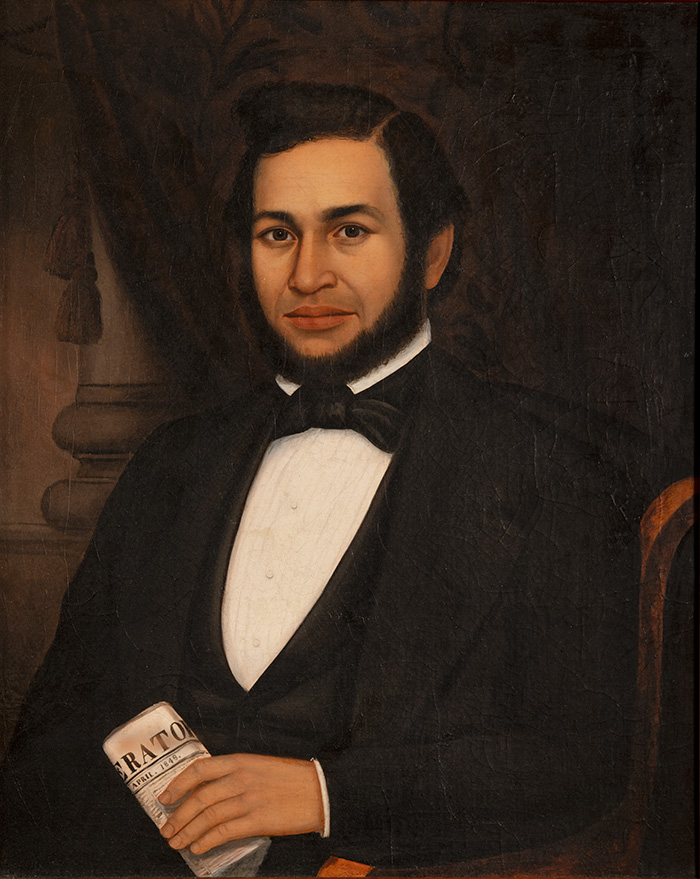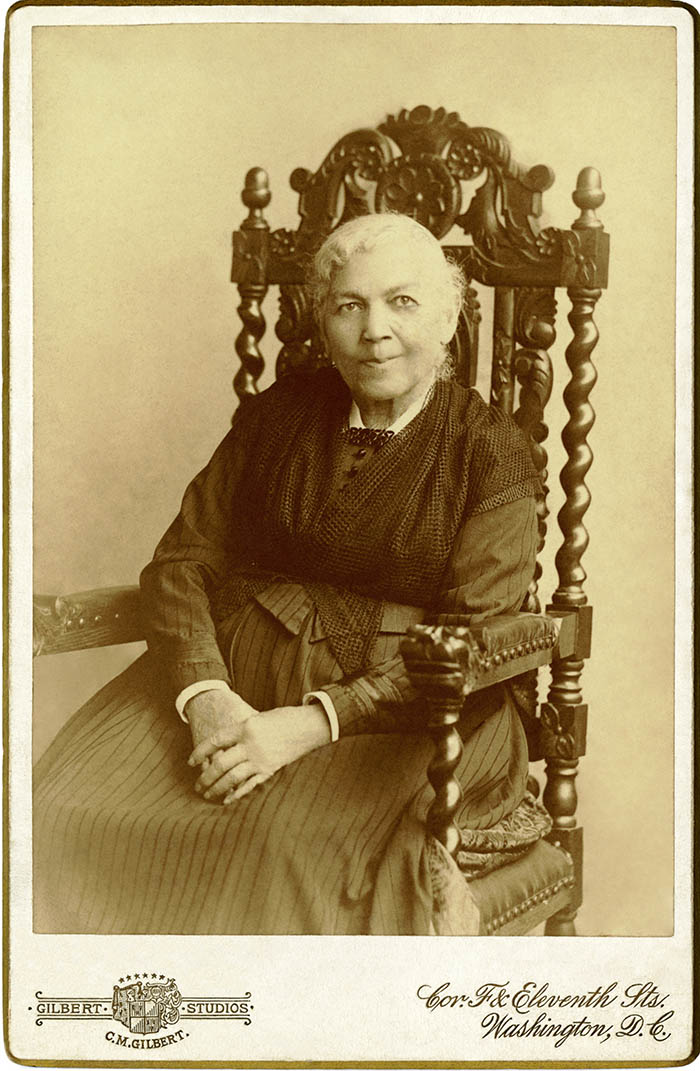
This summer the University of Chicago Press published The United States Governed by Six Hundred Thousand Despots: A True Story of Slavery; A Rediscovered Narrative, with a Full Biography. For the republication, Jonathan D. S. Schroeder, PhD’16, gathered John Swanson Jacobs’s letters and other writings, wrote a detailed biography of Jacobs, and even identified a painting he believes depicts Jacobs. (Joseph Whiting Stock, A Portrait of John Swanson Jacobs [currently known as The Man Holding the “Liberator”], 1848; courtesy of the African American Museum in Philadelphia.)
Jonathan D. S. Schroeder, PhD’16, rediscovered a forgotten 19th-century text—then unearthed its author’s extraordinary life story.
In 2016 Jonathan D. S. Schroeder, who had recently completed his PhD in English at UChicago, was engaged in one of the many side quests that inevitably accompany academic research.
His dissertation focused on the transformation of nostalgia from an 18th-century medical diagnosis of pathological homesickness, often applied to displaced and marginalized groups, to the emotional state we think of today—a sentimental, bittersweet longing for things past.
For a chapter about how enslaved and formerly enslaved people experienced what doctors then called nostalgia, he had been reading about Harriet Jacobs, author of the 1861 autobiography Incidents in the Life of a Slave Girl, Written By Herself. Schroeder, PhD’16, learned that Harriet’s son, Joseph, had moved to Australia and later died, possibly by suicide. He wanted to see if he could find a cause of death for Joseph, because at the time suicide was sometimes said to result from nostalgia.
Schroeder began searching through various databases to see if he could learn more about Joseph’s life and death. Trove, a digital archive of Australian newspapers and periodicals, seemed especially promising. But finding information about the right Joseph Jacobs was tricky, he says: “‘Joseph Jacobs’ is a super common name for an immigrant moving to Australia in the 19th century.” So he also tried searching for John S. Jacobs, Harriet’s brother and Joseph’s uncle, thinking that the combination of a first name and middle initial might lead him to the right Joseph.
The search turned up something else entirely: a 20,000-word article from April 1855 in the Sydney newspaper the Empire, published under the title “The United States Governed by Six Hundred Thousand Despots.” Although the narrative was published with the byline “A Fugitive Slave,” it used the real names of the author’s family and associates, so Schroeder quickly came to suspect he was reading John Swanson Jacobs’s life story. Halfway through the article, the hunch was confirmed—Jacobs had inserted his real name into the story.
Schroeder had never seen the document referenced anywhere, and he felt its importance instantly. This was a singular piece of writing, one that differed in striking ways from other accounts from the same period written by formerly enslaved people. Part autobiography, part polemic, the furious narrative seemingly took its title from Jacobs’s estimate of the number of slave owners in the United States at that time.

“I was kind of in a tizzy,” Schroeder says. He began emailing and calling colleagues and mentors around the country, asking what he should do next.
Their advice set him on a multiyear research project that resulted in the first stand-alone edition of The United States Governed by Six Hundred Thousand Despots: A True Story of Slavery; A Rediscovered Narrative, with a Full Biography, published this summer by the University of Chicago Press. For the republication, Schroeder gathered Jacobs’s letters and other writings, wrote a detailed biography of Jacobs, and even identified a painting he believes depicts Jacobs.
Together, the materials tell the story of a fiercely intelligent man intent on denouncing the injustice at the heart of his country and articulating the urgent need for abolition. “The day must come; it will come,” Jacobs writes in Despots. “Human nature will be human nature; crush it as you may, it changes not; but woe to that country where the sun of liberty has to rise up out of a sea of blood.”
The rediscovery and republication of the text is “an extraordinary contribution to the canon of slave narratives—thus a contribution to American history and to the history of the Black diaspora,” says Bill Brown, Karla Scherer Distinguished Service Professor in American Culture and one of Schroeder’s UChicago advisers. Despots stands out “for all the reasons that Jon outlines in his introduction to the work—the absence of a White abolitionist mediator, the aggressive tone, the full frontal attack on US political institutions. … It will be read and reread, studied, and cherished for its detailed belligerence.”
Tracing Jacobs’s life story was an entirely new kind of project for a literary scholar like Schroeder. “I had to retrain and develop the skills of an archival historian,” he says. The task was made more complicated by the fact that enslaved people were documented only as property, not as people, and that Jacobs spent much of his later life as a sailor and miner, moving from place to place.
For scholars working on so-called history from below, figuring out how to piece together a story from limited records is a constant challenge: Can you “apply the same standards of evidence to, say, a biography of George Washington as to a biography of a person for whom records were not saved and collected?” Schroeder asks. At times, inference had to fill in the gaps left by the historical record.
Still, despite these constraints, Schroeder was able to reconstruct a remarkably comprehensive account of Jacobs’s life. The text of Despots itself was rich with detail; the 2004 biography of Harriet Jacobs by Jean Fagan Yellin provided another essential resource. Archival shipping records in London and New Bedford, Massachusetts, helped Schroeder map Jacobs’s long career as a sailor.
What we know with certainty, from Jacobs’s own words, is that he felt the profound injustice of his circumstances from a young age. “My father taught me to hate slavery; but forgot to teach me how to conceal my hatred,” Jacobs writes. He resisted in whatever small ways he could, for example, by refusing to call his enslaver’s children “Master” and “Miss.”
Escape became Jacobs’s ultimate ambition. He’d seen others in his family take the risk. His uncle successfully escaped; his sister, Harriet, went into hiding in 1835. And while it’s unclear whether Jacobs knew the details of the story, his grandmother had, as a young woman, briefly escaped to the North—only to be sent back to her enslavers in the first court case to test the 1793 Fugitive Slave Act.
Jacobs meticulously planned his escape. As he writes in Despots, “I had rather die a free man than live a slave.”
He finally took his chance in 1839 when his then enslaver, the North Carolina congressman Samuel Tredwell Sawyer, brought Jacobs along on a trip to New York. While there, Jacobs slipped out and boarded a steamship bound for Providence, Rhode Island. (He’d secretly sold his best clothes to pay for the ticket.) As he could read but not write at the time, he instructed a friend to send a note to Sawyer on his behalf. It concluded simply, “No longer yours, John S Jacob [sic].”
Jacobs made his way to New Bedford, a town that had become both a safe haven for fugitive slaves and a center of the whaling industry. Like many other men in his position, Jacobs went to sea after his escape, spending three and a half years aboard the Frances Henrietta. He studied in his spare time on board, teaching himself to write and reading abolitionist literature.
In 1843 Jacobs returned stateside. He became active on the abolitionist lecture circuit, befriending figures including Frederick Douglass and William Cooper Nell. He also reunited with Harriet and her son, Joseph. (For a brief period, he took a break from lecturing and ran an oyster saloon in Rochester, New York—an unexpected side career.)
This fruitful period in Jacobs’s life was cut short in 1850 by the passage of the second Fugitive Slave Act. The legislation permitted the seizure of escaped slaves, even in free states and without due process, extending the legal reach of slavery and threatening the already fragile compromise between slave and free states. The new law was intensely divisive; indeed, many historians see it as having put the nation on the path to war. As a personal matter, Jacobs felt in real peril of being forcibly returned to North Carolina.
Schroeder found an account of a speech Jacobs gave at a rally soon after the legislation had passed; in it, Jacobs urged resistance at any cost: “They said that they cannot take us back to the South; but I say, under the present law they can; and now I say unto you, let them only take your dead bodies,” he told the crowd.
To guarantee their safety, some formerly enslaved people allowed White abolitionists to purchase their freedom. (In fact, this was how Harriet Jacobs was emancipated in 1852.) But Jacobs saw the practice as an unacceptable form of compromise, one that condoned the buying and selling of human beings. He never allowed anyone to buy his freedom.
It was a principled stance—and a personally costly one. At risk in the North, he headed west to mine in gold rush California, where the new legislation did not yet apply. (His nephew, Joseph, eventually joined him there.) But his respite was brief: in 1852 California passed its own fugitive slave law. Accompanied by Joseph, Jacobs set out for Australia, the country in which he would write and publish Despots, and one in the midst of its own gold rush. Jacobs and Joseph were among the estimated 5 percent of Black Americans who left the United States after 1850.
Schroeder sees these years as intensely formative for Jacobs. As fugitive slave laws spread, the possibility of remaining in his home country was taken from him. “I think that the tone of Despots is related to the passage of the second Fugitive Slave Act,” Schroeder says. “It seems doubtless that this radicalized him.”
Despots fits into a complex and heterogenous genre known as the slave narrative. (This term makes some scholars uneasy—Schroeder prefers “emancipation narrative”—but it is the most widely used.) All told, there are about 6,000 extant slave narratives, the majority of which are audio recordings collected in the 1930s through the Works Progress Administration; there are only about 200 book-length narratives like Despots.
Yet these texts, especially the ones from the 19th century, were shaped by certain “invisible constraints,” as Schroeder puts it. White abolitionist editors wanted particular kinds of stories: the slave narratives that got published tended to follow a standard arc from birth to escape and included graphic details of barbarity intended to arouse outrage and sympathy.
Harriet Jacobs’s Incidents in the Life of a Slave Girl—which was heavily shaped by its White editor, Lydia Maria Child—conforms in many ways to this pattern. Child also excised material from Harriet’s manuscript, including a chapter on the radical abolitionist John Brown, that brought focus to the political, rather than personal, aspects of her story.
But in Australia, Jacobs could write his story exactly as he saw fit. “Outside of American jurisdiction and humanitarian authority, he had more freedom to speak in an unfiltered way and write in an unfiltered way,” Schroeder says.
Jacobs’s tone is forceful and unsentimental; rather than detailing the cruelties inflicted on him, he focuses his attention on the people and institutions that allowed the injustice of slavery to continue. In the last several sections, Jacobs eschews conventional autobiography, moving away from his life story and toward a methodical, point-by-point argument for abolition.
Throughout Despots, Jacobs is unsparing in his critique. His home country, he writes, is tainted by “that devil in sheepskin called the Constitution of the United States” and no one is free from guilt by association. “The people of the north cannot plead ignorance to the sin of slavery,” Jacobs writes. Since the passage of the 1850 Fugitive Slave Act, “they can no longer say, ‘This sin does not lie at my door;’ they can no longer say, ‘I am not my brother’s keeper.’ The blood of your coloured countrymen cries out against you—the laws of God condemn you.”
It’s unclear how Despots was received in Australia when it was first published. Whether the piece was celebrated, criticized, or ignored, Jacobs would have had little time to take in the reaction. Just a few months later, he was on the move again.
Leaving Australia, Jacobs settled in London and resumed his career as a sailor. “Settled,” of course, is a relative term—Schroeder estimates that, on average, Jacobs spent about two months at home for every 10 months abroad.
Already well traveled, he saw even more of the world. Jacobs crisscrossed the globe, visiting the Caribbean, South America, and the Middle East. He used his unusual vantage point to help the abolitionist cause, writing letters to friends and antislavery organizations about the shifting attitudes toward slavery around the world as well as the trade in Chinese indentured servants. As Schroeder puts it, “he was the abolitionists’ eyes and ears on the world.”
In an 1861 letter to the abolitionist Isaac Post, Jacobs vowed not to return to America until slavery was abolished. In the end, he waited even longer—until 1873, a full decade after the Emancipation Proclamation was issued—to go home. He had, in a very literal sense, spent his years living out the abolitionist slogan “Our country is the world, our countrymen are all mankind.”
Schroeder, who is currently a lecturer at the Rhode Island School of Design, is not finished with John Jacobs yet. He hopes to write a multigenerational biography of the Jacobs family, one that builds on his and Yellin’s research. (He’s also at work on Lauren Berlant, A Reader [Duke University Press, forthcoming] with Lauren Michele Jackson, PhD’19, and Jean-Thomas Tremblay, PhD’18, as well as Prisoners of Loss: An Atlantic History of Nostalgia [Harvard University Press, forthcoming], a book based on his dissertation.)
Despite all we now know about the life of John S. Jacobs, there is much we still do not. Schroeder says he is continually struck by this sense of absence. The very question that led Schroeder to start his research project—What happened to Jacobs’s nephew, Joseph?—sits open. We have little information about Jacobs’s marriage and family life, and we don’t know why he decided to return to the United States when he did. What he was like as a person is another blank space. His tombstone says only “Brother.”
Schroeder sees Jacobs as one of many Black Americans from this era whose stories have been lost and need recovery. (Arguably, in fact, Jacobs’s life story is far better preserved than many of his contemporaries’.) In the records that survive, people like Jacobs are “not given individuality. They’re treated as a population to be measured by the Census, and then multiplied by three-fifths,” Schroeder says. Who they were, what mattered to them, what meaning they made of their lives: these questions remain unanswered.
Seeing John Swanson Jacobs

This painting, found at a Cape Cod antique sale in the 1970s, is now part of the collection of the African American Museum in Philadelphia. The portrait, which has been identified as the work of the artist Joseph Whiting Stock, features a man holding an April 1848 edition of the Boston-based abolitionist publication the Liberator. Descriptions of John Jacobs’s appearance match with the sitter of the portrait; what’s more, Jacobs, who had ties to the Liberator, was in Massachusetts in April 1848, when several other likely sitters were not.
“I’m 99 percent positive this is John Jacobs,” Schroeder says. Yet, as he writes in an essay in the new edition of Despots, “identifying an image of a person who exists only in words is a riddle with no obvious answer.”
The life of John Swanson Jacobs
| c. 1815–18 | Born in Edenton, North Carolina | |
| 1839 | Escapes slavery | |
| 1839 | Takes his first paying job as a sailor aboard the Frances Henrietta | |
| 1850 | Moves to California to work as a miner | |
| 1852 | Arrives in Australia and continues working as a miner | |
| April 1855 | Publishes “The United States Governed by Six Hundred Thousand Despots” in the Sydney newspaper the Empire | |
| 1857 | Moves to London and resumes work as a sailor | |
| 1862 | Marries Eleanor Aspland, a widow and mother of two children | |
| 1866 | Eleanor gives birth to Jacobs’s only biological child, Joseph Ramsey Jacobs | |
| Early 1873 | Returns to the United States | |
| December 19, 1873 | Dies in Cambridge, Massachusetts |
Siblings and scholars

Decades before Jonathan Schroeder began studying John Swanson Jacobs, the work of Jacobs’s sister Harriet underwent its own scholarly rediscovery. Incidents in the Life of a Slave Girl, which was published pseudonymously under the name Linda Brent in 1861, recounts Harriet Jacobs’s remarkable life story, including the seven years she spent hiding in her grandmother’s tiny attic before finally escaping to freedom.
The book was presented as autobiography, but many scholars did not see it that way. For years Incidents was viewed as a work of fiction, allegedly written by its White editor, Lydia Maria Child.
The late literary critic and historian Jean Fagan Yellin read Incidents while writing her dissertation and came to believe it was, in fact, a true story. Through letters and archival research, Yellin was able to conclusively prove her case in a 1981 article. She later published a biography of Harriet Jacobs that also provided key information about the life of John Jacobs.
